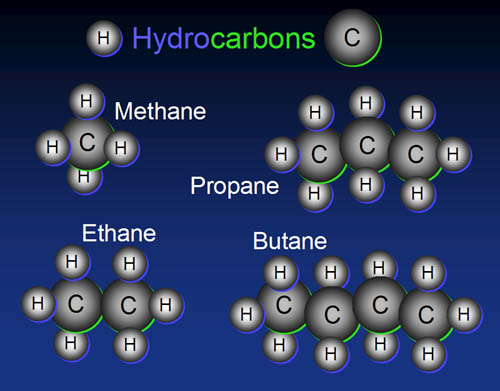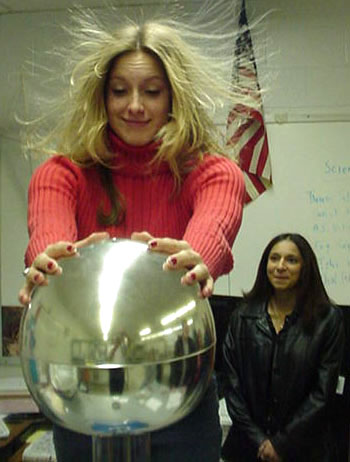| 1.
In the picture we see that the man is made of lego building blocks. Later
we will see that everything in the picture is made of building blocks. Those
that make up the wood, glass, and cement are too small to see. If you were
standing about a hundred yards from our lego man, could you see the lego
building blocks? And might you mistake him as a real person? |
 |
| 2.
On the right is a representation of a plastic called Low Density Polyethylene
or LDPE for short. It is used to make squeeze bottles. The larger gray spheres
are carbon atoms, and the white spheres are hydrogen atoms. What is the
smallest repeating unit (building block) that would build these chains? (hint: It's 3 atoms)
|
 |
|
#3. The equation E=mc2 can be used to calculate
energy given off when mass is converted to energy or how much energy is
required to create a certain amount of mass. A grain of sand weighs about
one millionth of a kilogram (1/1,000,000). Plug this into the formula
as:
E=
1 kg x 300,000,000 x 300,000,000
1,000,000
This
answer will be in watt-second (joules). Divide that answer by 3,600,000
to get kilowatt-hours. Now multiply by 0.10 (10 cents) to get dollars
of electricity to create the mass for a grain of sand. What's your answer?
|
 |
|
#4. Here is a guy who scares his neighbors with his Tesla
coils. The sparks are streams of electrons flying off the left donut-shaped
metal. Electrons (or electricity) don't usually jump into the air because
air resists any electrons trying to move through it.
Look at the below illustration of the electromagnetic
spectrum. Sparks and lightning produce light (electromagnetic radiation)
across most of the spectrum. You have noticed how your radio or TV gets
interference from lightning. That's because these produce radio and microwaves.
What you don't see is the dangerous ultraviolet light and xrays that sparks
create. Our friend here probably doesn't realize the amount of electromagnetic
radiation he is exposing himself. I'd say the ultraviolet rays would be
the most abundant light. Do a Web search and report on some dangers to
health that ultraviolet light causes.
|
 |
|
|
|
#5. You learned that a proton, that is
positively charged is attracted to an electron that is negatively charged.
They pull on each other with equal force. So in our picture the two will
move towards each other. But knowing that the electron is 2,000 times
lighter than the proton, do you think they will meet halfway? Explain
your answer.
|
|
|
6. From the salad, you are acquainted with the building
blocks for the elements at a personal level. Match the atomic particle
to the correct sense.
1. Protons
2. Electrons
3. Neutrons.
Senses: Sight, Taste, Pressure (from weight)
|
 |
| 7. A fundamental law
about charges is demonstrated in this static electricity picture. Electrons
move up to the girls hair and then the hair separates. What can you say
about the force that electrons have on other electrons? |
|
| 8. In the picture of
the helium atom to the right, we see the electrons staying away from each
other, but the protons (+) seem to disobey the rule about like charges repelling.
How is it that protons will sit up against each other in the nucleus of
an atom? (Also, mention the name of the force that overcomes the electrical repulsion force) |
|
| 9. Ionic bonding occurs
when two charged atoms (ions) have opposite charges. Which two atoms to
the right will be attracted to each other? (hint: count protons and electrons) |
|
10. In the movie, "Total
Recall", the alien factory could decompose ice in the Martian soil
into oxygen and hydrogen. That would require very high temperatures and
would end up with a flammable mixture of oxygen & hydrogen. A better
idea is use the iron oxide that is in Martian soil. That would turn into
iron metal and oxygen gas at a temperature much lower than decomposing water.
What temperature is necessary to decompose red iron(III) oxide (Fe2O3)
which will liberate oxygen? (hint: Do a Google search for: iron oxide melting point. A Wikipedia article should come up. Check it out). |
 |
|
11a) What are the three most abundant elements in the
Earth's crust?
11b) In the picture snow is on the
Earth's crust, so what additional element besides the three mentioned
in "11a" is sure to be present?
|
 |
|
In an early tutorial you learned about
stone tool technology. A favorite mineral used to make knives and arrowheads
was obsidian. In the tutorial, I said it is made mostly of "silica."
Go to the below site and type in silica to get more info.
http://en.wikipedia.org/wiki/Main_Page
12a)What is the chemical formula for silica?
12b) Name at least two things made from silica?
|
|
| 13. What element is
in all organic compounds? |
 |
| 14. Hydrocarbons are
the simplest of all organic compounds, but which hydrocarbon is the simplest? |
 |
|
15. Building blocks have to connect to other blocks. In
the picture we see oxygen, hydrogen, and carbon. Looking at the number
of outer electrons each have and the number of vacancies each have...
A) ...what is the maximum of atoms hydrogen can connect to? ...oxygen
can connect to? and carbon can connect to?
B) Which element is the most versatile then?
|
 |
| 16. To the right are
some of the smaller organic acids, with formic acid being the smallest.
Many birds hunt for formic acid. Do a Web search for bird
anting and report what that is and why birds like formic acid. |
 |
| 17. Creating flavors
is a big industry and two of our organic compounds (alcohols and organic
acids) are common ingredients. Here we see how ethanol (drinking alcohol)
and butyric acid combine to make a pineapple flavor. I like the aroma of
pineapple and that of ethanol. But what does butyric acid smell like? |
 |
18. We often hear
consumers complain about artificial flavors, but most products still have
them. Visit the below link and read enough to come up with three reasons
why artificial flavors are so common despite the complaints.
|
 |
| http://www.uefap.com/reading/exercise/kavaler/kavaler6.htm
|
19. Collagen is a great
example of building blocks. With just three amino acids that repeat, it
forms long twisted strands (a triple helix). About one quarter of all of
the protein in your body is collagen.
9a)What parts of the body use collagen?
9b) What is special about the places where I circled "H" and "OH"? |
 |
| 20. To the right is
a summary of what elements are needed to make each category of organic compounds.
There is just one error. RNA and DNA only need five of the six elements.
Which element is not needed? |
 |




















